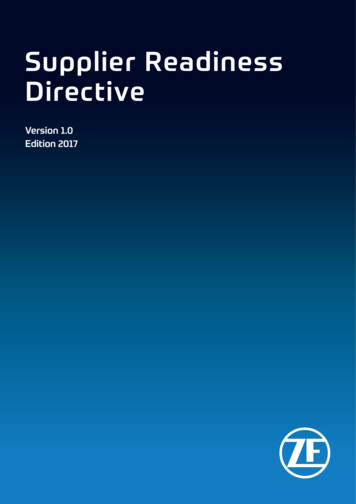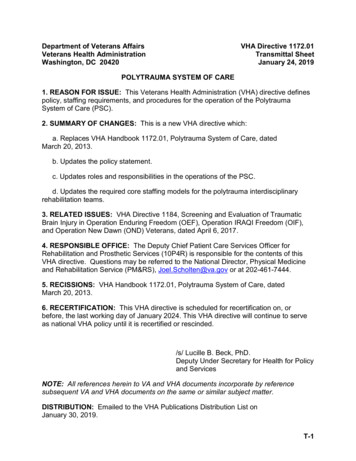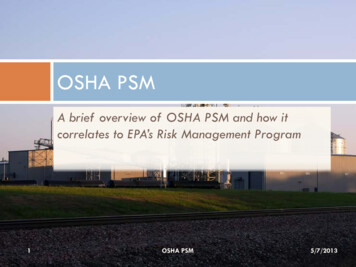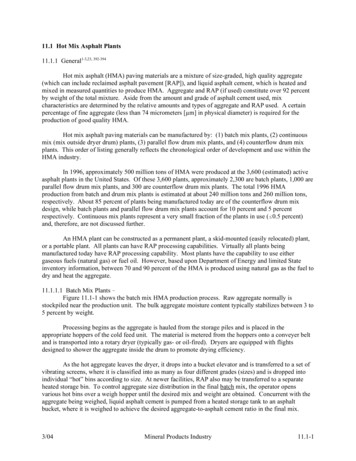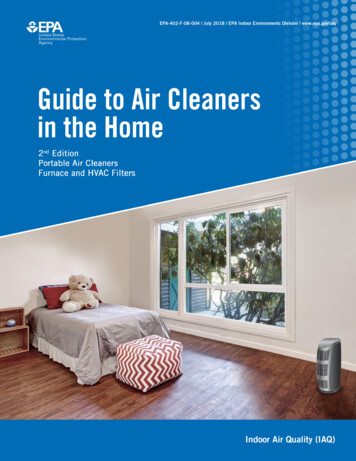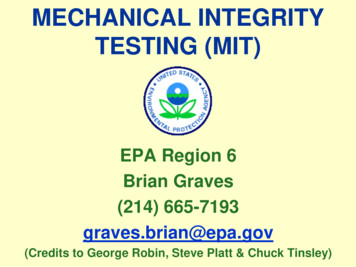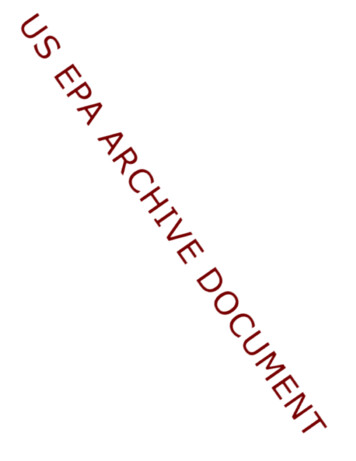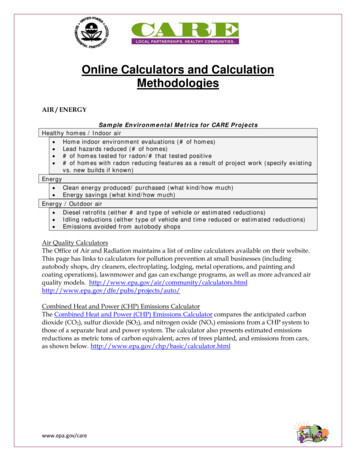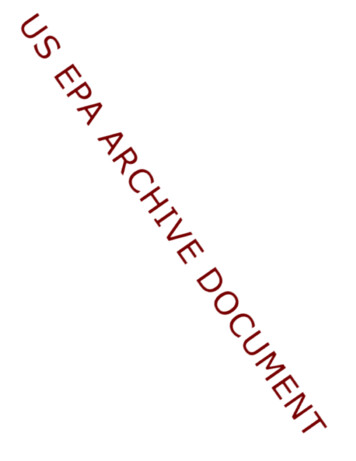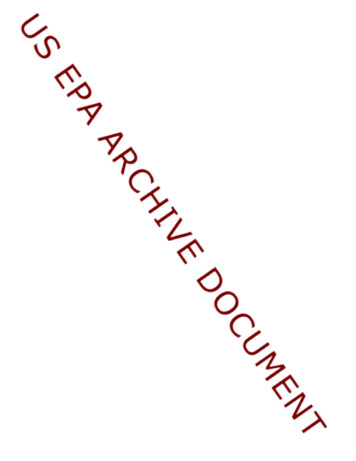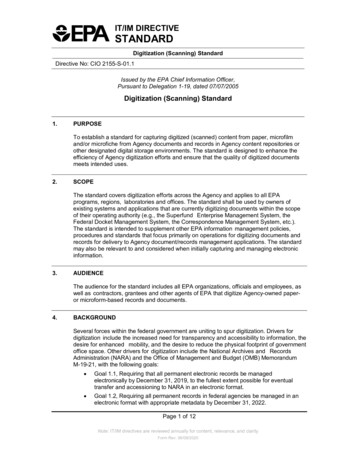
Transcription
IT/IM DIRECTIVESTANDARDDigitization (Scanning) StandardDirective No: CIO 2155-S-01.1Issued by the EPA Chief Information Officer,Pursuant to Delegation 1-19, dated 07/07/2005Digitization (Scanning) Standard1.PURPOSETo establish a standard for capturing digitized (scanned) content from paper, microfilmand/or microfiche from Agency documents and records in Agency content repositories orother designated digital storage environments. The standard is designed to enhance theefficiency of Agency digitization efforts and ensure that the quality of digitized documentsmeets intended uses.2.SCOPEThe standard covers digitization efforts across the Agency and applies to all EPAprograms, regions, laboratories and offices. The standard shall be used by owners ofexisting systems and applications that are currently digitizing documents within the scopeof their operating authority (e.g., the Superfund Enterprise Management System, theFederal Docket Management System, the Correspondence Management System, etc.).The standard is intended to supplement other EPA information management policies,procedures and standards that focus primarily on operations for digitizing documents andrecords for delivery to Agency document/records management applications. The standardmay also be relevant to and considered when initially capturing and managing electronicinformation.3.AUDIENCEThe audience for the standard includes all EPA organizations, officials and employees, aswell as contractors, grantees and other agents of EPA that digitize Agency-owned paperor microform-based records and documents.4.BACKGROUNDSeveral forces within the federal government are uniting to spur digitization. Drivers fordigitization include the increased need for transparency and accessibility to information, thedesire for enhanced mobility, and the desire to reduce the physical footprint of governmentoffice space. Other drivers for digitization include the National Archives and RecordsAdministration (NARA) and the Office of Management and Budget (OMB) MemorandumM-19-21, with the following goals: Goal 1.1, Requiring that all permanent electronic records be managedelectronically by December 31, 2019, to the fullest extent possible for eventualtransfer and accessioning to NARA in an electronic format. Goal 1.2, Requiring all permanent records in federal agencies be managed in anelectronic format with appropriate metadata by December 31, 2022.Page 1 of 12Note: IT/IM directives are reviewed annually for content, relevance, and clarityForm Rev. 06/09/2020
IT/IM DIRECTIVESTANDARDDigitization (Scanning) StandardDirective No: CIO 2155-S-01.1 Goal 1.3, Requiring all temporary records in federal agencies to bemanaged in electronic format or stored in commercial recordsstorage facilities by December 31, 2022. Goal 2.4, Requiring NARA to no longer accept transfers of permanent ortemporary records in analog formats (hardcopy, microfilm and microfiche) andonly accept records in electronic format and with appropriate metadata, afterDecember 31, 2022.Benefits from the standard include: Productivity improvement due to enhanced access to Agency records/documents; Reduction in the time and effort required to search for documents and recordsneeded for a variety of regulatory and mission-related reasons; Decrease in the number of filing errors and the volume of duplicate content; Reduction in and better management of the overall volume of hard-copy (paper)information; Easier data sharing among information systems across the enterprise; and Enhanced identification, sharing and use of Agency information resources byEPA’s information customers and stakeholders.The electronic management of digitized documents and records will also result insubsequent reductions in the costs associated with paper-based documents and records.The standard is thus designed to:5. Support the migration from hard-copy/paper-based documents to electronicdocuments; Integrate and standardize the digitization process as part of the records life cycle; Leverage existing Agency investments in the EPA Enterprise Architecture (e.g.,Documentum and its enterprise storage environment, scanners, etc.), EnterpriseContent Management (ECM) systems such as the Correspondence ManagementSystem (CMS), Federal Docket Management System (FDMS) and SuperfundEnterprise Management System (SEMS), and Enterprise Information Management(EIM); Serve as a framework into which additional program-specific standards andworkflows can be incorporated, based upon the needs of the business units; and Establish the basic standard business practices necessary to satisfy therequirements of the Federal Rules of Evidence, the Federal Records Act, andother authorities, policies and procedures under which the Agency must operate,such as NARA and known best practicesAUTHORITY Clinger-Cohen Act (also known as Information Technology Management Reform Act of1996) (Pub. L. 104-106, Division E) Paperwork Reduction Act of 1980, as amended by the Paperwork Reduction Act of1995 (44 U.S.C. Chapter 35) Government Paperwork Elimination Act of 1998 (Pub. L. 105-277, Title XVII)Page 2 of 12Note: IT/IM directives are reviewed annually for content, relevance, and clarityForm Rev. 06/09/2020
IT/IM DIRECTIVESTANDARDDigitization (Scanning) StandardDirective No: CIO 2155-S-01.16. United States vs. Russo, 480 F.2d 1228, 1239 (6th Cir. 1973) Presidential Memorandum: Managing Government Records, November 28, 2011 Presidential Memorandum: Building a 21st Century Digital Government, May 23, 2012 Executive Order – Making Open and Machine Readable the New Default forGovernment Information, May 9, 2013 NARA/OMB Directive M-12-18: Managing Government Records, August 24, 2012(Superseded by M-19-21) OMB Circular No. A-130: Management of Federal Information Resources OMB Memorandum M 10-06: Open Government Directive, December 8, 2009 OMB Memorandum M-13-13: Open Data Policy - Managing Information as an AssetMay 9, 2013 CIO 2130.1: Section 508: Accessible Electronic and Information Technology February20, 2014 icy/2130.1.pdf) NARA/OMB Memorandum, M-19-21: Transition to Electronic Records, June 8, 2019STANDARDEPA programs, regions, laboratories and offices are directed to: Use the digitization standard for capture of hard-copy documents and records inAgency content repositories or other designated storage environments (e.g., CMS,FDMS), where use does not jeopardize existing standard business practices; and Incorporate the digitization standard into documented standard operatingprocedures (SOPs) to ensure consistency across the Agency and establish theframework for legally-defensible standard business practices for digitization. Foradditional information on digitization SOPs, please refer to the related EPAInformation Directive – Digitization (Scanning) Procedure Ensure the parameters inform the equipment selection, as well as the decision toperform the work at EPA or through a contract vehicleHardware (“brand neutral”) StandardA. Low volume scanner standardThe standard designates the acceptable scanner device for low volume (i.e.,incidental/infrequent use for small-batch jobs 25 pages) applicable for the scanning ofstandard office paper materials only: Desktop/stand-alone flatbed scanners; Multi-function copier/printer machines; All-in-one scanners/printers; andWide-format scanners for oversized documents, up to 34 in. x 44 in. (i.e., pagemeasurement standards ISO-A0 and ANSI-E).B. High volume scanner standardThe standard designates the acceptable scanner devices for high volume (i.e., frequent Page 3 of 12Note: IT/IM directives are reviewed annually for content, relevance, and clarityForm Rev. 06/09/2020
IT/IM DIRECTIVESTANDARDDigitization (Scanning) StandardDirective No: CIO 2155-S-01.1use for large-batch jobs 25 pages) applicable for the scanning of standard officepaper materials only: 1,000 page/hour minimum throughput; Compatible with Enterprise Capture Software standard (see software standardbelow); ISS- and Twain-driver compatible; Native (on board), or compatible with, Kofax Virtual Re-Scan (VRS ) qualityenhancing production software, or alternatively, the Captiva /Input Accel ImageQuality Checks feature; Sheet size capability from 2.05 in. x 2.91 in. (i.e., page measurement standardISO-A8) up to 11 in. x 17 in. (i.e., page measurement standards ISO-A3 and ANSIB); Duplex (2-side scanning) capability; and Color, gray-scale and monochrome capability.C. Film digitizers standard (e.g., microform, microfilm, slides, etc.)The standard directs users to address the following characteristics that may influencethe digitization approach or affect the digital image quality: The type and volume of the materials to be digitized;Text quality and clarity on the microfilm;The quality of the original capture of the film (lack of focus, uneven lighting, pagecurvature, gutter shadows, etc.);Variations in density between exposures;The reduction ratio of the film;Resolution and the ability to detect detail on the film; andThe condition of the film itself (scratches, etc.).Digitizing and capture software standardThe standard here applies only to new acquisitions or upgrades to the software already inuse in the Agency. They are not intended to require wholesale replacement of softwareused now or in the past.D. Low volume digitizing and software applications standard Stand-alone (non-networked) usage:o Manufacturer-supplied capture software;o Manual submission of output to Enterprise Capture Software (see below); ando Network-attached usage: Integrated with Enterprise Capture Software (see below).E. High volume digitizing and software standard Enterprise Capture (high volume, as defined in the high volume scanner standardabove) network-attached usage:oEMC Captiva (InputAccel )Page 4 of 12Note: IT/IM directives are reviewed annually for content, relevance, and clarityForm Rev. 06/09/2020
IT/IM DIRECTIVESTANDARDDigitization (Scanning) StandardDirective No: CIO 2155-S-01.1oKofax Capture (Multiple server-level installations across the Agency)F. Analog or film based digitizing and software standard (e.g., microform, microfilm, slides,etc.) Manufacturer-supplied capture softwareContent digitized file format standardG. PDF/A-1 file format standard (Portable Document Format/Archive) Preferred format for documents that are primarily textual in nature; Image-over-text content indexing (a.k.a., optical character recognition, or OCR); Optimized for Internet/Web streaming; NARA preferred specification for transfer to Archive:o ISO 19005-1:2005 electronic document file format for long-term preservation –part 1: Use of PDF 1.4 (PDF/A-1): (https://www.iso.org/standard/38920.html)o Not the preferred output for non-networked scanning of textual documentswhere that output should be passed on to Enterprise Capture software forprocessing (see the TIFF file format standard below)o Not the preferred output for non-textual materials such as graphics, maps andphotographs (see the JPEG file format standard below)H. TIFF file format standard (formerly Tagged Image File Format) Preferred format for low volume, stand-alone document scanning where the TIFFfile can be passed on (manually or via automated workflow) to Enterprise Capturesoftware for additional processing such as OCR, image enhancement, conversionto PDF/A, etc.NARA specification for transfer to Archive:o TIFF Revision 6.0 Final – June 3, 1992 Adobe Systems, Inc.( ards/tiff/TIFF6.pdf)I. JPG file format standard (Joint Photographic Experts Group) Preferred format for non-textual documents that are primarily graphical (image) innature, e.g., maps, photos; Compression should not result in an image quality of 10% or less than the originalimage to preserve image quality while minimizing file size; NARA specification for transfer to Archive:o ISO/IEC 15444-1:2004 Information technology – JPEG 2000 image codingsystem: Core coding system (https://www.iso.org/standard/37674.html)Content image standardJ. Image resolution standard Predominately textual documents:o Good-to average quality originals – Bi-tonal (2-bit), scanned at a minimum of300 pixels per inch (ppi), up to 600 ppio Average-to-poor quality originals – Low inherent contrast, staining or fading,Page 5 of 12Note: IT/IM directives are reviewed annually for content, relevance, and clarityForm Rev. 06/09/2020
IT/IM DIRECTIVESTANDARDDigitization (Scanning) StandardDirective No: CIO 2155-S-01.1e.g., carbon copies, thermofax, NCR/carbonless paper or documents withhandwritten annotations or other markings – Bi-tonal (2-bit), scanned at aminimum of 400 ppi Predominately textual documents of good-to-poor quality with gray-scale or colorillustrations, photos or text containing color important to interpretation or content –24-bit RGB (Red, Green, Blue), scanned at 300-400 ppi Non-textual (or minimal text content) graphics, illustrations, photos, charts and maps– 24-bit RGB (Red, Green, Blue), scanned at 300-400 ppiNOTE: Depending upon the type of scanner and capture software used, it may beuseful and more convenient to simply apply the settings for 24-bit RGB (Red, Green,Blue), scanned at 300-400 ppm (as described above) as a default for all documentscanning.K. Skew standard Three degrees (3⁰) or less When using scanners so equipped, the skew standard setting should be applied tothe Kofax Virtual Re-Scan (VRS ) quality-enhancing production software, oralternatively, the Captiva /Input Accel Image Quality Checks feature, in order tooptimize batch processing and to ensure the skew standard is monitored by thesoftwareL. Speckle standard Five percent (5%) or less When using scanners so equipped, the speckle standard should be applied to theKofax Virtual Re-Scan (VRS ) quality-enhancing production software, oralternatively, the Captiva /Input Accel Image Quality Checks feature, in order tooptimize batch processing and to ensure the speckle standard is monitored by thesoftwareM. Contrast and brightness standard Due to variances in scanners and software, each digitization installation should runtest batches of documents to be digitized to determine the capture software contrastand brightness setting calibrations that are needed for optimum document viewing,utility, and production software functionality When using scanners so equipped, the settings determined from the operationsdescribed in the above bullet should be applied to the Kofax Virtual Re-Scan (VRS ) quality-enhancing production software, or alternatively, the Captiva /InputAccel Image Quality Checks feature, in order to optimize batch processing and toensure the minimum contrast and brightness parameters are monitored by thesoftware.Output information standardN. Content indexing standard (a.k.a., Optical/Intelligent Character Recognition – OCR, ICR) Only with human review and re-keying can 100% content indexing accuracy forscanned documents be achieved. For truly effective, efficient and accurate retrievalof digitized content from content management systems, content indexing must bePage 6 of 12Note: IT/IM directives are reviewed annually for content, relevance, and clarityForm Rev. 06/09/2020
IT/IM DIRECTIVESTANDARDDigitization (Scanning) StandardDirective No: CIO 2155-S-01.1supplemented by cataloguing (indexing) documents for metadata-based searches,as described in the cataloguing and categorization standard below. All textual documents should be content indexed during the digitization/captureprocess Whenever possible, content indexing should be accomplished using the EnterpriseCapture software standard described above. For low volume scanners, this mayrequire passing TIFF file output to the Enterprise Capture software, utilizing theAgency’s data network(s), secure Web portal, or via secure emailO. Cataloguing and categorization standard (metadata indexing) Associating metadata with an imaged (scanned) file is necessary to meet theNARA’s definition of a high-quality “production master image.” Additionally, 100%accuracy in content indexing (see content indexing standard above) is rarelyachieved during scanning operations. This necessitates the cataloguing of scannedcontent in order to maximize the power, effectiveness and accuracy of enterpriseinformation search/retrieval tools Digitized documents should generally be catalogued using the Agency’s InformationStandard: Enterprise Information Management (EIM) Minimum Metadata Standard(see Section 8 below) – or depending upon the source and type of document, usingother appropriate Agency metadata standards – and more granular documenttaxonomies, as registered in the Agency’s data resource registries and repositoriesQuality standardP. Quality assurance and quality controlQuality control during the digitization process, and quality assurance ofdigitized content, is critical to ensuring the integrity, reliability and utilityof the content for uses that support the Agency’s mission. Some basic QA and QC operations should be incorporated in the capture processthrough the use of quality-enhancing production software tools such as VRS(Kofax) and Captiva’s Image Quality Checks feature (see the output informationstandards above) To ensure an effective and consistent approach to QA and QC, digitization/captureshould conform to a formal Agency-level Quality Assurance Plan (QAP),developed and established for Agency digitization operations, pursuant to the CIO2106: Quality Policy; Procedure for Quality Policy and NARA’s DigitizationStandards found at 36 CFR Chapter XII, Subchapter B, Part 1236, Subpart D.NOTE: For waivers to the Content Parameters, see Section 10.7.ROLES AND RESPONSIBILITIESThe roles and responsibilities with respect to the digitization standards include:The Chief Information Officer (CIO) Lead Agency-wide implementation of the Digitization Standard as part of thePage 7 of 12Note: IT/IM directives are reviewed annually for content, relevance, and clarityForm Rev. 06/09/2020
IT/IM DIRECTIVESTANDARDDigitization (Scanning) StandardDirective No: CIO 2155-S-01.1overall framework of CIO Policies Facilitate the process for appropriate business organizations to incorporate thestandards into their organization and operations Manage the Senior Advisory Council process to update the standards andassociated policies and procedures, and propose new information policies,procedures and standards as needed Authorize formal information calls for updates or reviews of the standard, asappropriate Grant waivers to selected provisions of the standard for sufficient cause, ordelegate waiver authoritySenior Advisory Council (SAC) Advise and assist the Chief Information Officer in developing and implementing theAgency’s quality and information goals and policies Review updates to the Digitization Standard and associated policies andprocedures, and propose new information policies and procedures as needed Review any progress reports provided and address successes, as well as Agencywide challenges, for the effective implementation of the standard Endorse enterprise-wide information investments, coordinating with AgencyInvestment Oversight Boards, as appropriateSenior Information Officials (SIOs) Implement the standard within their organizations Apprise the SAC of major digitization issues within their offices Ensure that the information technology used and managed by their organizationssupports their business needs and mission and helps to achieve strategic goals Ensure Enterprise Architecture compliance of solution architectures Review, concur, and advise on waivers to the standards, typically throughparticipation on the Information Technology Operations Planning Committee (IOPC)Records Liaison Officers (RLOs) Participate in the development and maintenance of digitization standard operatingprocedures, as appropriate, for relevant programs, regional offices, laboratories,etc. Support and implement the
o EMC Captiva (InputAccel ) Digitization (Scanning) Standard . Directive No: CIO 2155-S-01.1 Page 5 of 12 . Note: IT/IM directives are reviewed annually for content, relevance, and clarity . Form Rev. 06/09/2020. IT/IM DIRECTIVE. STANDARD. o Kofax
